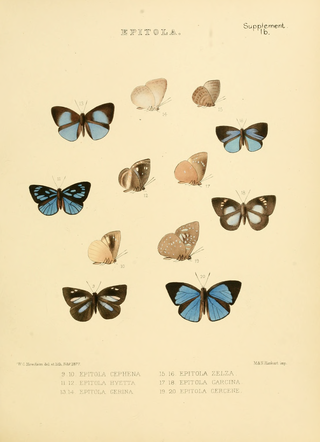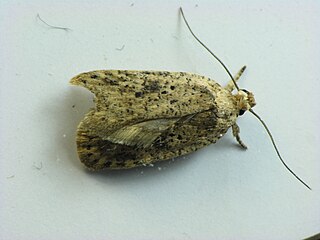
Lepidoptera is an order of insects that includes butterflies and moths. About 180,000 species of the Lepidoptera are described, in 126 families and 46 superfamilies, 10 percent of the total described species of living organisms. It is one of the most widespread and widely recognizable insect orders in the world. The Lepidoptera show many variations of the basic body structure that have evolved to gain advantages in lifestyle and distribution. Recent estimates suggest the order may have more species than earlier thought, and is among the four most speciose orders, along with the Hymenoptera, Diptera, and Coleoptera.

Moths are a group of insects that includes all members of the order Lepidoptera that are not butterflies. They were previously classified as suborder Heterocera, but the group is paraphyletic with respect to butterflies and neither subrdinate taxa are used modern classifications. Moths making up the vast majority of the order. There are thought to be approximately 160,000 species of moth, many of which have yet to be described. Most species of moth are nocturnal, but there are also crepuscular and diurnal species.

The Sphingidae are a family of moths (Lepidoptera) called sphinx moths, also colloquially known as hawk moths, with many of their caterpillars known as “hornworms”; it includes about 1,450 species. It is best represented in the tropics, but species are found in every region. They are moderate to large in size and are distinguished among moths for their agile and sustained flying ability, similar enough to that of hummingbirds as to be reliably mistaken for them. Their narrow wings and streamlined abdomens are adaptations for rapid flight. The family was named by French zoologist Pierre André Latreille in 1802.

The Arctiinae are a large and diverse subfamily of moths with around 11,000 species found all over the world, including 6,000 neotropical species. This subfamily includes the groups commonly known as tiger moths, which usually have bright colours, footmen, which are usually much drabber, lichen moths, and wasp moths. Many species have "hairy" caterpillars that are popularly known as woolly bears or woolly worms. The scientific name Arctiinae refers to this hairiness. Some species within the Arctiinae have the word "tussock"' in their common names because they have been misidentified as members of the Lymantriinae subfamily based on the characteristics of the larvae.

The Tortricidae are a family of moths, commonly known as tortrix moths or leafroller moths, in the order Lepidoptera. This large family has over 11,000 species described, and is the sole member of the superfamily Tortricoidea, although the genus Heliocosma is sometimes placed within this superfamily. Many of these are economically important pests. Olethreutidae is a junior synonym. The typical resting posture is with the wings folded back, producing a rather rounded profile.

Concesio is a town and comune in the province of Brescia, in Lombardy in Trompia valley. It is located 8.2 kilometres (5.1 mi) north of Brescia and 6.8 kilometres (4.2 mi) south of Sarezzo. Concesio is located in the lower Val Trompia, at the foot of Monte Spina. The comune is bounded by other communes of Brescia, Bovezzo, Lumezzane, Villa Carcina, Gussago and Collebeato.
Sarezzo is a comune in the province of Brescia, in Lombardy. It is located in the Trompia valley. Neighbouring communes are Lumezzane, Villa Carcina, Polaveno and Gardone Val Trompia. In 2011 its population was 13,547. The comune is made of four frazioni (villages): Sarezzo, Zanano, Ponte Zanano, and Noboli, although today these have grown into each other and there is no visible distinction. Indeed, Sarezzo, 13 km from the city centre of Brescia, is today part its urban area.
Villa Carcina is a comune in the province of Brescia, in Lombardy. Neighbouring communes are Concesio and Sarezzo. Situated on the river Mella, it is part of the Trompia valley.
The Val Trompia is a slightly more than 50 km long valley in the Province of Brescia, northern Italy. It consists of the valleys of the river Mella and its tributaries, north of the city of Brescia. It is situated between Val Camonica, Val Sabbia and Lake Iseo.
Paolo Bossini is an Italian breaststroke swimmer. He was European Champion in 2004, both short and long course, in 200 m breaststroke. He achieved the 4th place in the same distance in the 2004 Summer Olympics. He lives in Switzerland at the moment.

Stempfferia is a genus of butterflies in the family Lycaenidae. The species of this genus are endemic to the Afrotropical realm.

Carcina quercana is a species of moth of the family Depressariidae. It is found in Europe. It has been introduced recently in North America, British Columbia and western Washington. It is occasionally known by several common names including oak lantern, long-horned flat-body, and oak-skeletonizer moth.

Karkinit, Karkinitski, Carcinites, or Karkinitsky Bay is a bay of the Black Sea that separates the northwestern Crimean Peninsula from the mainland Ukraine. It was named after the early Greek settlement of Kerkinitis (Κερκινίτης) on the Crimean coast in place of modern Yevpatoria.
The Peleopodinae are a subfamily of small moths in the family Depressariidae.

Depressariidae is a family of moths. It has formerly been treated as a subfamily of Gelechiidae, but is now recognised as a separate family, comprising about 2,300 species worldwide.

The Erebidae are a family of moths in the superfamily Noctuoidea. The family is among the largest families of moths by species count and contains a wide variety of well-known macromoth groups. The family includes the underwings (Catocala); litter moths (Herminiinae); tiger, lichen, and wasp moths (Arctiinae); tussock moths (Lymantriinae), including the arctic woolly bear moth ; piercing moths ; micronoctuoid moths (Micronoctuini); snout moths (Hypeninae); and zales, though many of these common names can also refer to moths outside the Erebidae. Some of the erebid moths are called owlets.

Stempfferia carcina, the dark furry epitola, is a butterfly in the family Lycaenidae. It is found in Nigeria and Cameroon. The habitat consists of forests.

Carcina is a moth genus of the family Depressariidae.
Carcina luridella is a moth in the family Depressariidae. It was described by Hugo Theodor Christoph in 1882. It is found in the Russian Far East and Japan.










